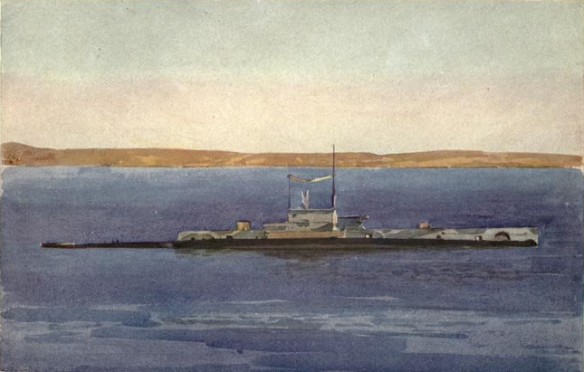British submarine HMS E11 off the Dardanelles.
Wilkinson, Norman (1915). The Dardanelles: Colour Sketches from Gallipoli. London: Longmans, Green, and Co. p. 106.
HMS E11 was an E-class submarine of the Royal Navy launched on 23 April 1914. E11 was one of the most successful submarines in action during the 1915 naval operations in the Dardanelles Campaign, sinking over 80 vessels of all sizes in three tours of the Sea of Marmara. Nasmith headed home on 5 June. On his return passage through the Dardanelles he encountered another transport which, despite his vulnerable position and the poor state of the submarine, he attacked and sank with his final two torpedoes. Passing through the Narrows near Çanakkale, E11 snagged a moored mine. Nasmith had to tow the mine out of the straits before he was able to disentangle the submarine. The crew of the HMS Grampas cheering the British submarine E11 after a successful raid on Turkish defences at Gallipoli.
May – June 1915
In one of the most daring naval actions of the First World War, a young Lieutenant-Commander Nasmith entered the Dardanelles in command of the submarine E11 on the 19th May in order to attack a Turkish Battleship. To do so he bravely had to dive below 90ft and pass right under 3 minefields – which must have been a mind-stretching experience in itself. On surfacing the battleship was no longer there. Instead there was a group of destroyers which on seeing his periscope, dispatched two of them with the orders to ram him. Nasmith cleverly avoided this threat and immediately went on to capture a dhow, lashing it tightly to the top of his conning tower – in order to disguise his progress through the inland waters.
On the 20th May he managed to put a boarding party aboard a sailing ship and torpedoed a Turkish gunboat at the expense of nothing more than a bullet hole in the E11`s periscope.
On the 24th May Nasmith sent to the bottom a vessel loaded with arms, 6-inch shells and gun spares after exploding it with a demolition charge after first ordering the crew to abandon it. He then went on to chase another similarly loaded ship into the nearby port of Rodosto – torpedoing her as she secured alongside. To cap the day off the prize sailing ship he had earlier captured ran itself ashore and his prize crew which he picked up had been driven off by rifle fire from a cavalry unit ashore!
The 25th May found Lt-Commander Nasmith just off Constantinople ready to attack the various enemy supply ships to be found in the Bosporus. Finding his first target he fired off a torpedo but it seemed to develop a gyro failure [common in First World War torpedoes] and it sped off around the harbour and narrowly missed his own submarine! His next torpedo fared more accurately and exploded and sunk the Turkish transport “Stamboul” as she lay alongside the harbour wall. The result of these actions caused total panic in Constantinople. Troops aboard transports were disembarked and all further sailings were cancelled. In addition all shops closed and the city came to a standstill.
On 27th May he attacked a Battleship but was driven off by a destroyer. He then attacked a Turkish Q-ship and again was driven off.
On 28th May he sank a large transport using demolition charges again. Later on the same day Nasmith himself bravely swam to a torpedo that he had fired but did not go off and made it safe – taking great care not to touch the whiskers of the firing pistol.
On his return passage to base Nasmith returned back under the three minefields, having to stop and free a mine-mooring cable that got stuck around one of the forward hydroplanes and went on to sink yet another transport. He arrived back in Britain on the 4th June.
During his patrol of 20 days Nasmith had sunk one gunboat, two ammunition ships, two transports and 2 further supply ships. In addition he had paralysed the Turkish war effort by blockading their army in port as well as severing their lines of communication.
Lt-Commander Nasmith won accelerated promotion to commander and became the third and most feted submarine commander to win the VC in the Dardanelles campaign.
He later became known as Admiral Sir Martin Dunbar-Nasmith, VC, KBE.
